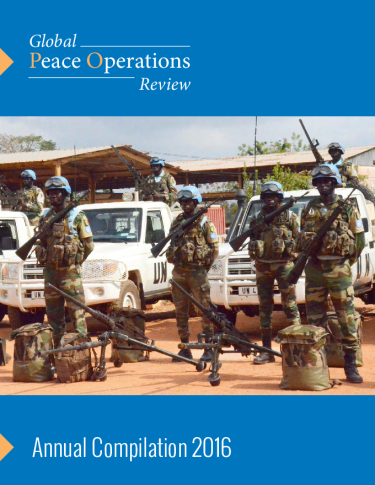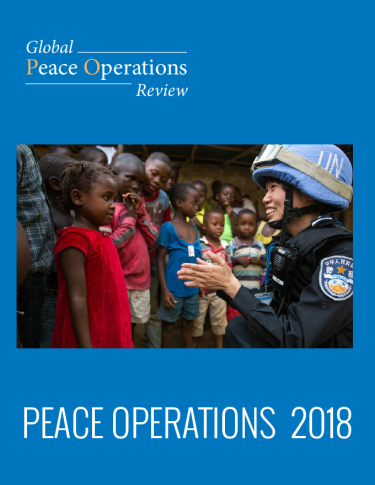For almost a decade, the Annual Review of Global Peace Operations (ARGPO) was the flagship publication of the Center on International Cooperation (CIC). During that time, CIC also released three editions of the Review of Political Missions. Together, they set the standard for analyzing UN and non-UN peace operations with enduring thematic essays, thorough country profiles, and detailed mission data.
Peace operations have evolved significantly over this decade and the way we analyzed them also had to change. While well received in the peace operations community in New York, the heavy books were expensive to produce and did not travel well. CIC wanted to get the analysis and data into the hands of a wider range of policymakers, those serving in peace operations in the field, and, most importantly, the citizens of those countries that rely on peace operations for their security.
Looking for a more efficient way to reach wider audiences, the Global Peace Operations Review (GPOR) was conceived. Initially, it was thought the website could be combined with a smaller print edition to act as bridge with the publication’s past. We thought CIC’s days of publishing “door stoppers” had ended.
Since its launch in late June 2015, GPOR has shown the utility of moving the publication online. In its first six months, 11,631 distinct users came to the site 17,253 times and viewed 28,893 pages of essays, commentary, data, maps, and infographics, which also make up content of this publication. While almost 40 per cent of the sites visitors are in the United States, mostly in New York City, as the map below shows, GPOR now has a verifiably global readership.
The website analytics tell us we have many readers inside the UN system, including headquarters, regional offices, and peace operations. The direct feedback from readers shows under-secretary-generals to blue helmets in the field access GPOR. Outside the UN, foreign ministries, government offices, international organizations, think tanks, NGOs, and universities are also well represented in the ranks of GPOR’s readers.
As regular visitors would have observed, the site is constant state of evolution. We have tried to cover a wide range of topics and also to bring an innovative spirit to the way we present information on the site. Resource constraints meant we had to postpone plans for an accompanying print addition. But feedback from readers, especially those in academic settings, suggested there was a still a demand for a more formal publication. With this support, we were pushed to explore what was possible given the people, funds, and time we had on hand.
This led us to explore new options and leverage the technology that we had available to us. First, we started compiling website posts into monthly newsletters in PDF format. At the end of 2015, we started work on compiling all the contributions from the year into one electronic document. We had a productive year and this new publication, known as the Global Peace Operations Review Annual Compilation 2015, is not an unsubstantial 245 pages. It is the end product of the efforts of the project team that created GPOR as well as the contributors and editorial team who have managed, curated, and evolved the website since its launch.
The Annual Compilation is something of a hybrid product. It looks like a book, has an ISBN, and it is now available for print-on-demand. Set in one column, the Annual Compilation is designed for screen reading. While the document is fully searchable and has hyperlinks embedded, it is still not quite a fully-fledged e-book. We’re still working on that. In the meantime, we hope it is a useful reference and we look forward to your feedback to help us improve the 2016 edition.
The creation and running of the Global Peace Operations Review has been a team effort. The initial project team consisted of Richard Gowan, Alischa Kugel, Calin Trenkow-Wermut, and Nora Gordon. The website was designed by the Community Systems Foundation and is managed by Webmaster Antonie Evans. The editorial team includes advisors John Karlsrud, Alexandra Novosseloff, and Yf Reykers. GPOR has been supported by data specialists Alison Burt and Ryan Rappa, Research Assistants Olivia Bergen, Lesley Connolly, Rahel Kroeker, Alex Nyikos, and Tyler Headley, Copy Editor Stephen Laifer as well as illustrators Erin Burt and Sam Minick.
Its development and ongoing work has been generously supported by the Australian Department of Foreign Affairs and Trade, the Ministry of Foreign Affairs of Denmark, the German Federal Foreign Office, the Norwegian Ministry of Foreign Affairs, and the Swiss Ministry of Foreign Affairs.
-
Download the annual compilation 2015
-
Access the annual compilation 2016
-
Purchase the annual compilation 2015 via Amazon
Note: CIC derives no income from the print-on-demand version of this publication and we are making it available at cost price for those who would like to access it in this paperback format.


